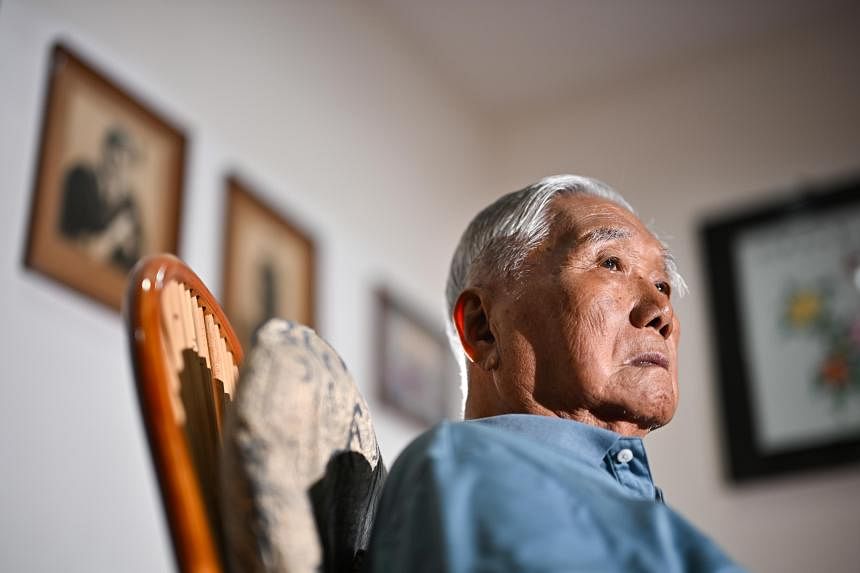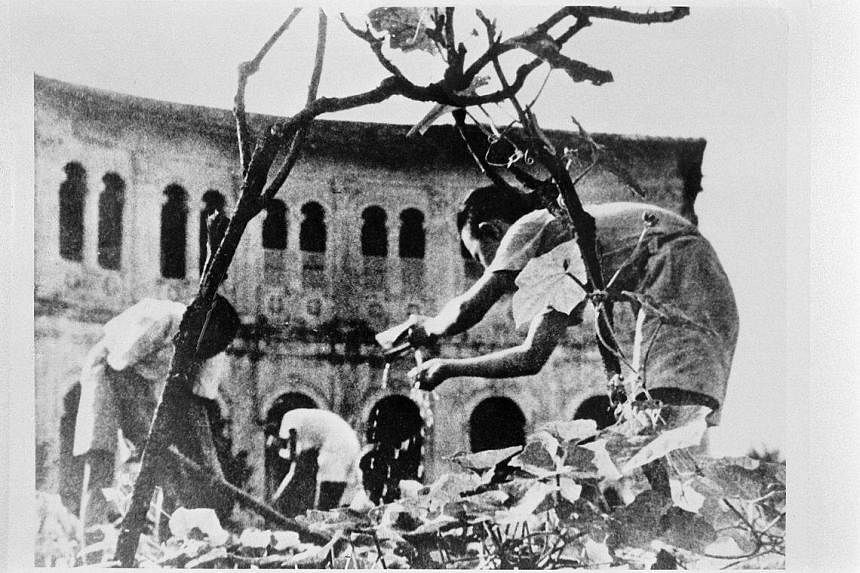‘I still can’t bring myself to eat Japanese food’: How WWII shaped the eating habits of a generation
The Battle of Singapore took place from Feb 8 to 15 in 1942 and was followed by the Japanese Occupation.

SINGAPORE – Over eight decades have passed, but Mr Ye Kun Chan, 88, still remembers that fateful evening like it was yesterday.
It was a Saturday, the eve of Chinese New Year, 1942. His family, unknowingly savouring the last dregs of their freedom, sat down for dinner. The then six-year-old was the first to finish and ran off to entertain himself.
Walking out of the dining room, a flash of movement caught his eye. He peered closer: The bushes were shaking violently. Then, he saw a hat – and not a normal one.
“I realised I was looking at not one, but three Japanese soldiers. I was terrified and immediately ran inside to tell my parents,” he says.
“That’s when I realised the Japanese had entered Singapore and our suffering had begun.”
He spent most of the next three years – until the end of the Japanese Occupation in September 1945 – hiding in his home in Beach Road with his older sister, shrouded in fear and misery. They subsisted on a diet of tapioca and unhusked rice, which Mr Ye says tasted of ash, “no matter how many times you washed it”.
And then there was the unimaginable cruelty. He recalls how the Japanese soldiers went on a rampage through his kampung shortly after their arrival – and what happened to his neighbours, who lived less than 100m away from his home.
“The soldiers set fire to their house. I can still remember their screaming.”
In the years that have followed, the former principal of Catholic High School has learnt to live with these memories.
He published personal essays in Chinese about his life, under the pen name Luo Ming, and even made Japanese friends. He also developed a grudging respect for Japan’s technological advancements.
Still, the writer tries his best to shun any reminders of Japan in his day-to-day life.
“I’ll eat sushi if my children buy it for me. But I won’t choose it for myself because I still feel a pain in my heart when reminded of that time,” he says in an interview at his home in Serangoon Gardens.
“Those who did not experience the Occupation would not really understand. It’s not that I simply hate everything Japanese. You have to understand the sort of suffering we went through, the circumstances of the time.”
Another survivor, Mr Tan Kim Wah, 96, refuses to touch Japanese cuisine altogether on the principle that it is the food of his oppressors.
He was 14 when the Occupation began and witnessed Japanese soldiers rounding up civilians for slaughter during Sook Ching, a mass killing that took place from Feb 18 to March 4 in 1942.
“They used a metal wire to pierce through the arms of their prisoners, stringing them together on the same wire – this made it impossible for them to escape. After that, they were loaded onto lorries to be taken to the massacre sites,” the retiree says.
Similar memories of bloody executions had haunted housewife Chew Yoke Cheng until her death at the age of 85 in 2017.
Her son, Dr Gary Lit, a 65-year-old retired academic, says: “My children like to go out to eat Japanese food, and every time they asked my mother, she would baulk at the prospect.
“Japanese restaurants sometimes displayed the national flag and other memorabilia, and it would make her shiver. She told me, ‘Every time I see a Japanese flag, my heart is gripped with fear and it starts pounding.’”
Not all members of that generation have such qualms, though.
Madam Helen Joseph, 94, periodically orders Japanese food for herself and a helper who lives with her. The widow, who used to work as a sales assistant at Robinsons department store, says she is not angry at the Japanese and has moved on with her life.
Forgive, but do not forget – it is an approach that Singapore on the whole seems to have adopted as well.
According to Dr Kei Koga, an associate professor at Nanyang Technological University’s Public Policy and Global Affairs Programme, relations between Singapore and Japan took a turn for the better in the 1980s and 1990s, when increased economic cooperation brought more Japanese expatriates and businesses – including restaurants – to Singapore.
Dr Clay Eaton, a lecturer at the National University of Singapore’s Department of Japanese Studies, adds that the way the war is remembered in Singapore has helped the country move forward too.
Education and public commemoration efforts often focus on the need for self-defence and self-sufficiency, rather than historical grievances.
In fact, the pendulum seems to have swung the other way – fascination with Japanese culture now grips many Singaporeans.
Japanese products have been so thoroughly embraced here that “it’s almost impossible to avoid them now”, Mr Ye quips.
Influence is not just shipped over in massive intermodal containers – who does not know someone who is enamoured with anime or J-pop? And their country of origin remains a top holiday destination – more than 86,000 Singapore residents visited Japan in November 2023 alone.
In the 2010s, Mr Ng Koon How, 82, who was born just before the Occupation, went on a holiday to Japan and enjoyed his trip, even donning a kimono during his visit. This was despite his resentment towards the Japanese for depriving him of milk powder during his formative years.
Dr Eaton says many survivors of World War II might not associate present-day Japanese food with the people who inflicted horrors on them.
“Much of the Japanese food that we’re familiar with here today – like sashimi – either wasn’t really available during the Occupation or didn’t even exist as we know it back then. So it might not always trigger those sorts of memories.”
One ingredient that is irrevocably associated with the war, however, is tapioca.
It was easy to grow and, as a result of a wartime campaign to encourage people to farm their own vegetables, became a widespread substitute for rice.
It is also the one thing that Mr Terry Tan, a cookbook writer and former chef, refuses to consume.
“We got so sick of eating tapioca during and after the war. Even today, I don’t like to eat it because it reminds me of poverty, of the sad old days,” says the 81-year-old, who was born in the first year of the Japanese Occupation.
Dr Lit’s late father, who worked as a taxi driver, had a similar approach to tapioca, avoiding it for much of his life because he was “sick of eating it during the war”.
It was only in his twilight years that he suddenly developed a craving for tapioca, “almost as if it conjured up a certain nostalgia for his childhood”, Dr Lit says.

Apart from tapioca, people relied on sweet potatoes, coconuts and tempeh. Though researchers say most did not starve, they had only a limited pool of ingredients to pick from, and their diets lacked protein and fat.
Severe malnutrition was therefore rife, along with conditions associated with it, such as beriberi.
A 2013 study published in the United States-based General Hospital Psychiatry journal has also found that modified eating as a result of war stress may increase the risk of civilians developing an eating disorder later in life.
The results were based on a survey of 303 young adults from Lebanon conducted six months after the 2006 Israel-Hezbollah War that killed over 1,000 people.
However, psychologists The Straits Times spoke to say this does not seem to be a common issue among Singaporean survivors of World War II.
Dr Tina Tan, a senior consultant psychiatrist at Better Life Psychological Medicine Clinic, says the cases of disordered eating in elderly patients she has treated are mainly caused by other issues, such as dementia or anxiety.
Moreover, examples of survivors developing war-related post-traumatic stress disorder (PTSD) in Singapore appear to be few and far between.
When Professor Kua Ee Heok, emeritus professor of psychological medicine at the NUS Yong Loo Lin School of Medicine, interviewed 612 war survivors aged 65 years old and above in Chinatown as part of a 1988 World Health Organisation global study on ageing, he found that only 3 per cent had PTSD.
“Many of these survivors from Singapore were immigrants who had survived cholera and typhoid. They had gone through difficult times and were quite strong mentally,” Prof Kua adds.
Regardless of how long it took survivors to come to terms with what happened during the Japanese Occupation, there is one common lesson most of them learnt from that period of scarcity.
“We never, ever threw away food in my family. If we had leftovers, we saved it up to eat in the night or the next day,” says writer and researcher Lee Geok Boi, 77, whose parents lived through the Occupation.
Madam Joseph also tried to inculcate such behaviour in her three children when they were growing up.
“Whenever my children complained that certain dishes were not nice, I would remind them that during the Japanese Occupation, I had very little to eat, so they had better finish everything on their plate.”
Mr Tan adds: “We had very little to work with and were forced to get creative with our local vegetables. Maybe that’s why we have so many ways to cook kangkong today.”


No comments
Share your thoughts! Tell us your name and class for a gift (: